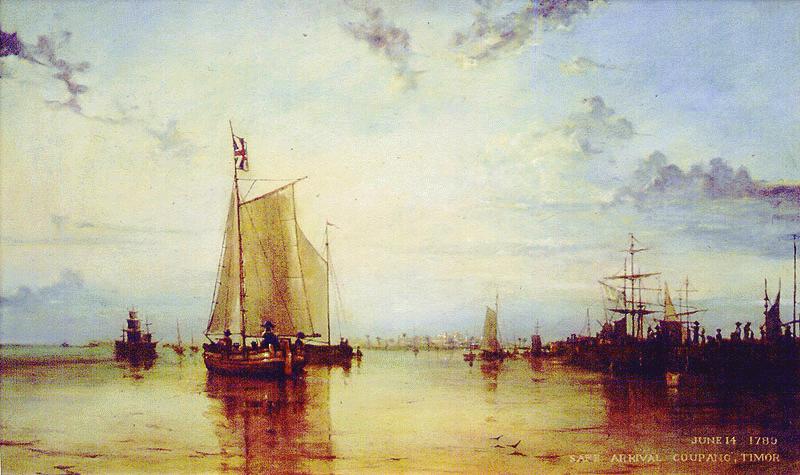| 3. FRONT, PICTORIAL AND AMBIGUOUS LIGHT
1. Front Light - the favorite of photographers,
two dimensional artists, children and colorists where emphasis is on color
and texture over form and value. Front light can eliminate the need for
shading and shadows (which is a pity for they are a great joy and keep
many artists from wandering aimlessly about the streets in the dead of
night). Front light is also excellent for use in portraits of unremarkable
people. Holbein's front light portrait of a Dutch princess eventually caused
the schism that resulted in the formation of the Church of England. Like good
putty front light can cover-up many faults.
USING THE JMW TURNER FRONTLIGHT PAINTING
TECHNIQUE: (From my 'Arrive Timor' (60" by 36") painting
from the Bounty series)
1. On a prepared canvas begin with a thin glaze (stand oil/spirit medium)
of yellow with touches of red and blue. (blue suggesting the distance,
yellow the middle ground and red the foreground). These thin 'washes' serve as
a beginning - the overal plan for solving the problems the subject presents.
2. After drying make light compositional drawing with chalk.
3. Lay in the large masses boldly with impasto white/color mixtures and allow to dry.
4. Draw/paint in the forms in greater detail with a light brown (burnt sienna).

5. Begin to add colour using glazes and scumbles.
Do not fear adding white to the glazes as this can create a broken light
effect. Build thin layers of colour on top of each other maintaining a
luminous transparency to the canvas and the textured white below. (note
- can be wiped)
6. Apply accents and details including dark local colours as well as impasto
white highlights strategically placed to give the effect of glimmering
light.
7. Finish the painting in the frame touching up with fresh varnish and
using thin brushes to drive paint into the cracks etc and other areas.
THEORY : In fact this method of painting I used copys Turner but most likely had its beginnings with Rembrant. It gains its effect by glazing over dried impasto to other textures. Rembrant devised a method employing two whites; one for impasto and one for smoother passages. The impasto white was faster drying, probably made so by the addition of egg and ground glass, into the formulation. It was very lean, and consisted mostly of white lead with a minimum of binder ( a variation on Step 1 above). He began applying it more and more heavily (Step 3 above) as the first stage of a two (or more) stage operation which was finished with transparent glazes and wiping, to create fantastic special effects, the most extreme example of which is the man's glowing, golden sleeve in the painting referred to as "The Jewish Bride," in the Rijksmuseum in Amsterdam. The brilliance of this effect cannot be gotten in any other way.
By wiping the glazes off as soon as they were applied, Rembrandt and later JMW Turner were able to create a bas relief effect of remarkable three dimensionality as the glaze remained in the nooks and crannies (Step 5-6 above). By glazing again, this time with transparent yellows and/or browns, instead of Ivory Black gave the textures a rich, golden glow (Step 7 above).
STUDENT ACTIVITY: Look up some paint manufacturers or go to your art supplier and find answers to these questions. Name three oils that can be used in oil paint manufacture. What is stand oil? How is sun-dried oil made? Name a non-drying oil. What is a varnish? What is a resin? What is a medium? Which is the most transparent white of those commercially available today? What medium is used for acrylic paints?
|